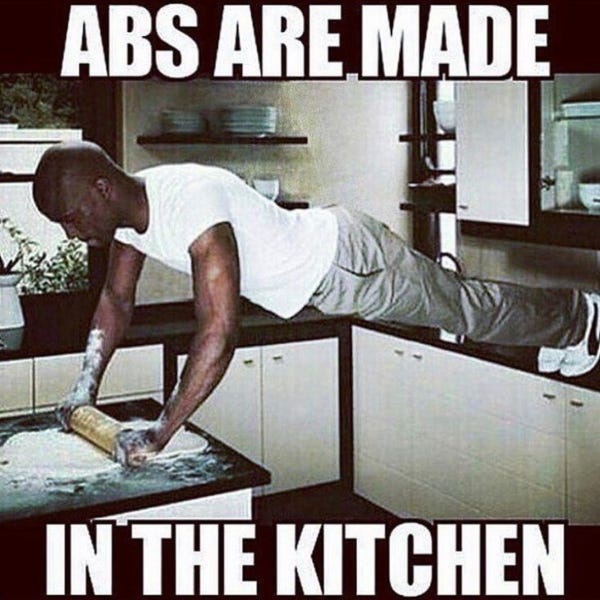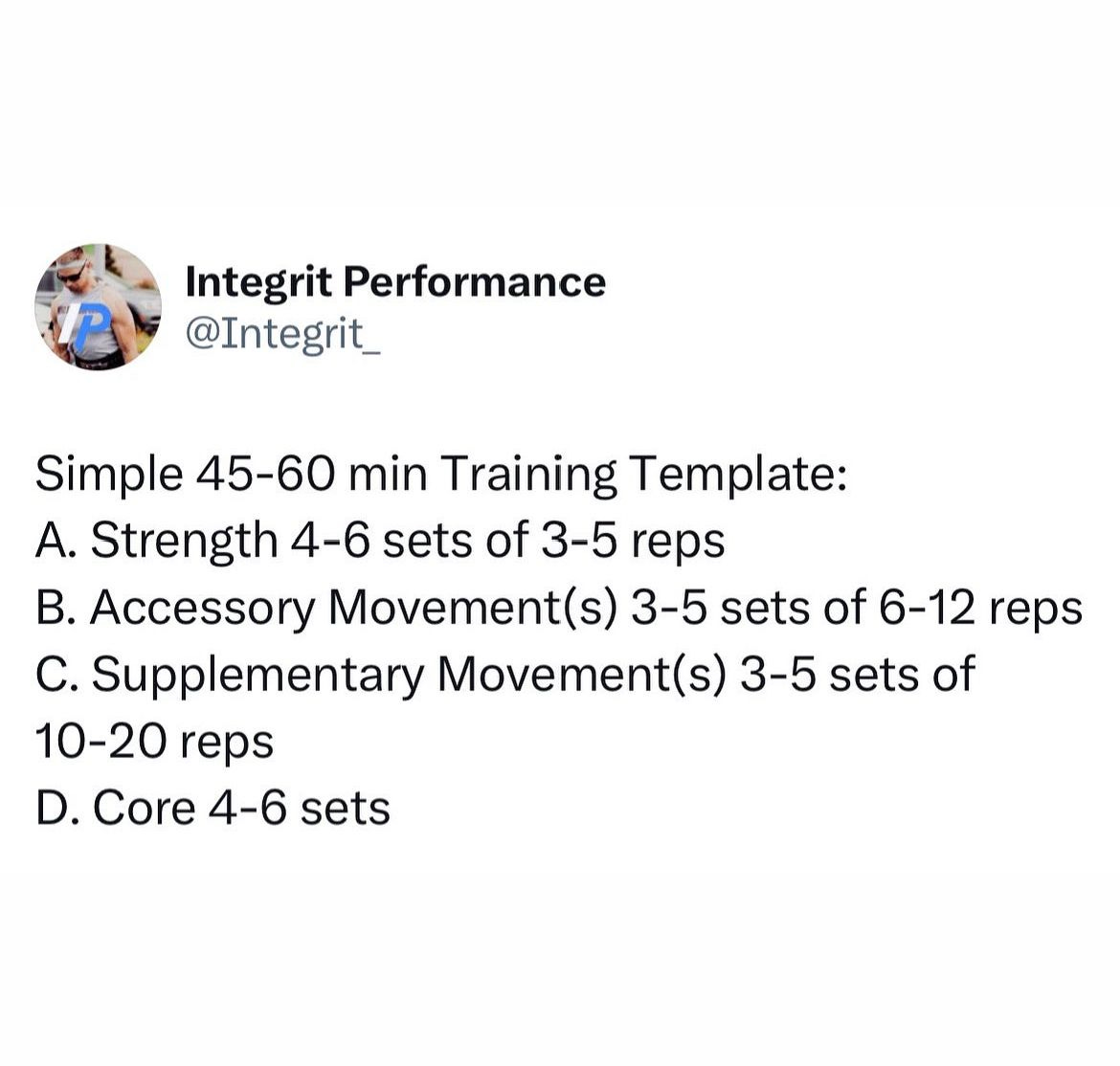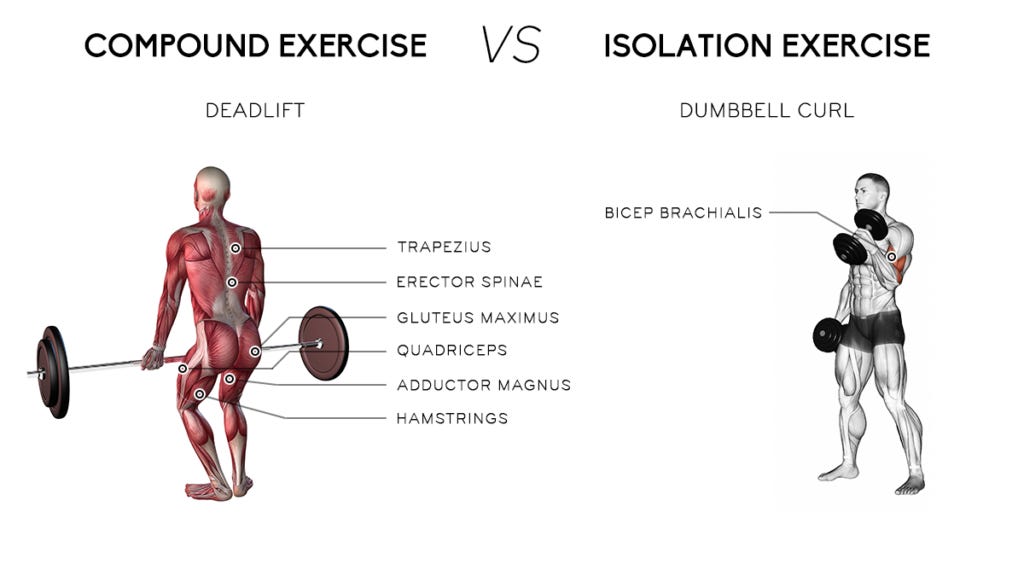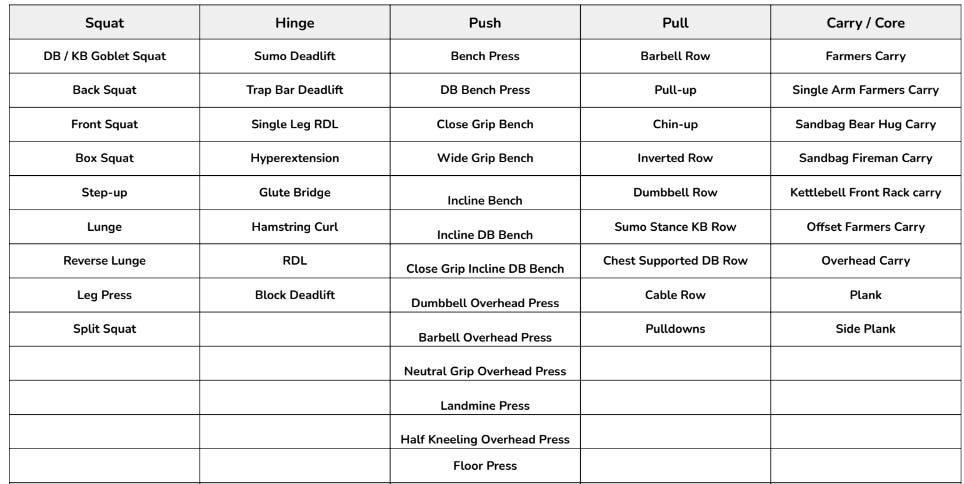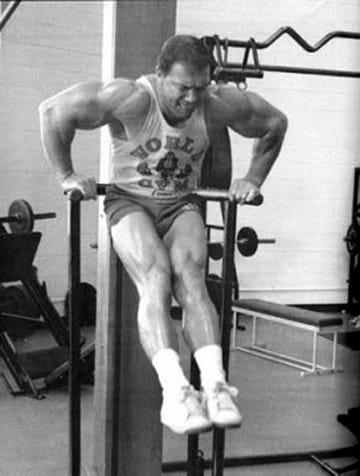There are countless training programs available online. Recently i’ve been downloading free ones from popular sources that I won’t name. I wasn’t impressed. Almost everything was just a bodybuilding bro split with 3 sets of 10 and way too many exercises. The internet provides an abundance of information and I can understand how that makes it difficult for novices to navigate the internet fitness scape.
That’s where simple strength comes in. This is a free template you can customize for your goals and continually reuse to get results forever. The template is, as the name indicates, simple. Simple scales, complex fails.
A lot of people like to think they’re snowflakes. They need a special protocol, carefully curated to their special snowflake body. When in fact, if you’re out of shape and just looking to build a good base of fitness, you can get by with just a few basics performed consistently and executed with high quality.
Simple Strength Template
When it comes to building a base of strength and muscle we want to prioritize compound movements. A compound movement is an exercise that uses multiple joints and works more than one muscle. An exercise that uses one muscle group is called an isolation exercise. Both a chin up and dumbbell curls work the biceps, but since chin ups also involve the shoulder & scapula, they have the benefit of simulatenously working the back and biceps.
Compound movements are efficient since they work more muscle groups throughout a workout you can spend less time in the gym and still get good results. Compound movements are also more stressful. People often think of stress as “bad” but stress can be categorized into distress (“bad” stress) and eustress (“good” stress).
If training isn’t stressful, your body has no reason to adapt to it. It’s important that your training is challenging enough to stimulate biochemical and structural changes in your physique.
A Series: Strength Exercises
B Series: Accessory Movements
C Series: Supplementary Movements
D Series: Core
Series can contain supersets. If you wanted to for example do an upper body day, you can do the following:
A1. Bench Press 4 x 4, 3010 tempo, RPE 7-8
A2. Chin-up 4 x 4, 3010 tempo, RPE 7-8
Both of these movements are compound exercises that work the upper body and it makes sense to pair antagonist movements together (a push with a pull). You can use supersets in the B series and C series as well. If you really want to get crazy, you could do giant sets (3 or 4 exercises back to back instead of just 2).
Movement Selection
Most of your movements should come from this list for the exercises in the A series (strength) and B series (accessory movements), the C series (supplementary movements) can be isolation movements. This way your training prioritizes using more muscles. Select just a few movements from each category that you’re comfortable performing, your program doesn’t need 100 different movements. Find 3 to 5 from each category that work best for your body and perform them consistently.
Programming: Setup Your Program
I’m going to attempt to outline programming for you in a couple of steps. It can be complicated, but it doesn’t need to be. Figure out these factors:
1.) How often will you train?
2.) What training split will you use? (Find your training split, click here)
3.) How many sets and reps?
If you want more work with the exercises, go to the higher end of the set and rep range.
If you only need a sprinkle of those exercises for gains, go toward the middle or lower range of the sets and reps. The section below goes into more detail about selecting rep ranges.
Use heavier reps to bias strength gain and lighter reps to bias muscle gain. Heavy reps can still stimulate muscle gain, but it’s easier to get sufficient volume with higher reps like sets of 8 than it is with sets of 3.
4.) What exercises? Choose 3 to 5 from each category in the chart above and distribute them into your week. For isolation movements, pick the ones that target weaknesses, feel the best, or just ones that give you big arms (who doesn’t want bigger arms?)
You did it. You now ave your first week of training. Now, how do you progress it?
Click Here For a Template You Can Print & Fill in
Programming: How to Progress Training (Periodization)
You can gain strength doing sets of 25, build muscle doing heavy sets of 3, and gain endurance doing sets of 6. But those aren’t the best rep ranges to choose for your goals. When you’re lifting, you’re always influencing protein synthesis regardless of the rep range you select. However, factors like mechanical tension (how you’re loading the muscle), volume, and metabolic stress will dictate the end result. To keep things simple, just use the general guidelines below. They’re not perfect, but for a novice they provide a good base to build your program from.
Strength Range: 3-5 reps
Strength/Hypertrophy Range: 6-10 reps
Hypertrophy Range: 8-12 reps
Hypertrophy/Endurance Range: 12-20 reps
Once you determined your reps you can begin to think through your progressions. I prefer novices to use rep ranges. Here is a sample training day to explain this:
A1. Bench Press 5 x 3-5, 2010 Tempo, RPE 8-9
B1. Incline Dumbbell Bench Press 4 x 8-12, 3010 Tempo, RIR 0-2
C1. Tricep Extension 3 x 10-15, 2010 Tempo, RIR 0-2
D1. Bosu Crunch 4 x 10-20, 2010 Tempo, RIR 0-2
Instead of just hitting a set of 5 in the bench, we’ll aim for 3 to 5 reps and keep a rating of perceived exertion of 8 to 9 (What is RPE?). Progress reps or weight weekly when allowed based on this intensity. I recommend 3 week blocks and after the 3 weeks you switch exercises in the plan and reset.
Intensity Progressions
Week 1: RPE 6-7
Week 2: RPE 7-8
Week 3: RPE 8-9
Week 4: Reset back to week 1 but now with new exercises to avoid accomodation.
For the B, C, and D series I recommend just adding reps whenever possible. If you can hit 12 reps every set of your incline dumbbell bench, you’re probably going too light. if you hit 12 reps, then 10, then 9, then 8 on your fourth set, maybe keep the weight next week and try to hit more total reps until you’re getting close to 12 each set. I prefer rep ranges for novices over straight sets since it’s easier to select approriately heavy weights and progress them gradually rather than jsut always adding weight to the bar.
That’s it, hope you found this helpful. If you need help building your plan as always just comment, shoot me a DM, or an email training@integritperformance.com and i’d be happy to help.
Up Next: Simple Strength Fitness Template




